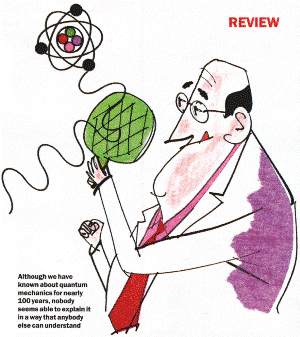
Not exactly a quantum leap
Roland White finds himself still
in the dark after a new attempt to make sense of physics
Scientists used to queue up to complain
that there was no decent science on the radio. They accused the long-haired,
woolly-headed arts graduates who ran the media of bunging up the schedules
with arts programmes. (I might have made up the bit about the long hair and
the woolly heads, but you get the drift.) Science lovers have a much better
deal these days, and they owe this partly to Melvyn Bragg. By bringing more
scientists on to Start the Week, he showed that it was possible for
science to appeal to a mainstream audience. Science's
problem is that it's much more difficult than the arts. Try reading
Hamlet and A Brief History of Time
and see which one is easier to finish. That's why there is more art than
science on the radio. At least, that's what I've always thought. And what
future generations will come to know as the White Hypothesis was perfectly
demonstrated by Quantum (Wednesdays Radio 4), the beginning of a four-part
attempt to explain quantum mechanics. The producer of Quantum faced
an immediate problem: although we have known about quantum mechanics for
nearly 100 years, nobody seems able to explain it in a way
that anybody else can understand. So much so that one of the great advances
in the field was the Copenhagen Interpretation, in which Niels Bohr said
there there is no point in trying to understand how
quantum mechanics works, it just does. Despite this, scientists have still
been trying to explain it in a simple way that the rest of us will understand.
Even in Quantum, experts tried to explain it in terms of a computer
print-out in a filing cabinet, a crime wave in the city, and a cat in a box
which might be alive or dead. None was particularly successful. Even the
experts are baffled. "I can safely say," said
Richard
Feynman, one of the great figures of quantum mechanics, "that nobody
understands quantum mechanics. Nobody understands how it can be like that."
The central mystery is the nature of light and other radiation. Until 1900,
light was thought to be a wave. Then it seemed to behave like a series of
particles. Eventually, it became clear that it behaved
both as a wave and a particle, which confused
everybody. Quantum is presented by John Gribbin, who has written an
excellent book on this subject called In Search of Schrodinger's Cat
(that's the one in the box). To be honest, I found that his book was
much easier to follow than his radio programme. With the book, we non-physicists
can keep flicking back the pages to reread the parts we obviously didn't
quite understand first time around. And when dealing with a concept that
nobody seems to understand, it's important to explain the easy bits. Quantum
mechanics was discovered, so Gribbin explained, after work on the problem
of black body radiation. In his book, so far as I remember, he goes into
this in some detail. On the radio, there was no clue as to the nature of
black body radiation at all except for a mention later of the mysterious
black body curve. That said,Quantum tackles a difficult subject in
an accessible way. I'll be making sure I don't miss the rest of the series.
The more science programmes there are, the more listeners will get to grips
with the subject. Perhaps then we might understand the greatest mystery of
all: Melvyn Bragg's hairdo wave or particle?
Upon this subject - it might be suggested that
people actually learn MATHS and then maybe they'd be able to understand Quantum
Physics in the language in which it is written -rather than having to suffer
analogies which only serve to confuse.